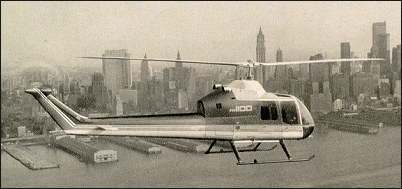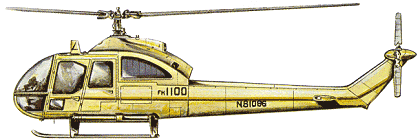
| Fairchild-Hiller FH-1100 1955 |  |
 |

| Fairchild-Hiller FH-1100 1955 |  |
 |
|
In May 1961 the Hiller Model 1100 was one of three designs selected by the U.S. Army for prototype evaluation in response to its LOH (Light Observation Helicopter) competition announced two years previously. Five HO-5 prototypes (later redesignated OH-5A) were ordered and detailed design work began in November 1961, the first machine (N81005) making its maiden flight on 21 January 1963. The OH-5A's were powered by 250shp Allison T63-A-5 shaft turbines and a feature of the aircraft was the 2-blade 'teetering' rotor, with the same Hamilton Standard stability augmentation system that is fitted to the commercial L-4 piston-engined helicopter. This was designed to provide automatic stabilisation of the rotor system, but can be over-ridden by the pilot if necessary. The OH-5A was designed as a 4-seater carrying a pilot and either 3 passengers or a 181kg payload. The LOH contract was eventually won by the Hughes OH-6A, but Hiller, which became a subsidiary of Fairchild Stratos in May 1964, has received some consolation in the reception given to the Model 1100 since, in February 1965, it decided to offer the helicopter in the civil market. Two factors have been of assistance here. One was that certification to FAA standard, required of all entrants in the LOH competition, was granted to the Model 1100 on 20 July 1964. Even more important was Hiller's deliberate disregard of the U.S. Army's astounding stipulation that the LOH design need have no 'built-in stretch' for future development, and as a consequence the civil FH-1100 represents a considerable advantage over contemporary rivals in terms of speed, range and general performance. One machine has already flown at over 257km/h. Some of the Army prototypes were reworked as civil demonstrators and production of an initial run of 250 machines is now in hand. The first production FH-1100 was completed in June 1966, delivery beginning shortly afterwards. By mid-1967 about sixty FH-1100's had been built to fulfil orders from the United States and other customers, and production was continuing at a rate of ten aircraft a month. The largest orders so far are for thirty FH-1100's for Okanagan and sixteen for the Royal Thai Police Department. The commercial Model 1100 is offered as a standard 4-seater, including the pilot, for executive and general business use, or as a utility 5-seater. Powerplant is the Allison 250-C18, civil version of the T63 engine, and the payload alternative to a full complement of passengers has been increased to 390kg. K.Munson "Helicopters And Other Rotorcraft Since 1907", 1968  The Hiller Model 1100 grew out of the US Army's specification for an LOH (Light Observation Helicopter). The competition was won by Hughes, so in the early 1960s Hiller had five high-speed five-seater helicopters on their hands. One went on display at the Le Bourget Air Show in 1965 and subsequently proved a modest success. The five prototypes were powered by a 250shp Allison T63-A-5 turboshaft engine. The first machine to fly (N81005) took to the air on January 21, 1963. These army prototypes were later reworked as civilian demonstration machines. An FAA (Federal Aviation Administration) type certificate was awarded to the Model 1100 on July 20, 1964. The FH-1100 is powered by an Allison 250-C18 which is the civil version of the T63 engine. The first production model was completed in June 1966. By the mid 1970s the initial production run of 250 machines was well under way. The FH-1100 has a baggage compartment which will take 68kg with seating for two or three stretchers and an attendant. It is available with a skid or float undercarriage. When it first came onto the market its turbine engine and power controls were in advance of anything then currently available in the civil helicopter field. It has a two-bladed semi-rigid teetering rotor with an automatic stabilizing system. This relieves the pilot of the need to attend constantly to the cyclic controls. The doors covering the stabilizer system serve, when open, as maintenance platforms for access to the engine top and transmission. The glassfibre engine-cowling slides aft for routine Inspection and maintenance. Prospective buyers saw that it could have military applications, but though the Dutch were reported to be evaluating it as an antisubmarine warfare helicopter in the 1960s, it remained largely a civil machine. The largest civil operator was Okanagan of Canada with 30 while the Royal Thai Police Department took 16. Argentina, Brazil, Chile, Cyprus, Ecuador, Panama, the Philippines and Salvador were single-figure customers. It has been used for executive, and business work in addition to the usual range of civil and police work. Bill Gunston "The Illustrated Encyclopedia of Commercial Aircraft", 1980
In May 1961, the Hiller Model 1100 was one of three projects chosen by the US Army for evaluation as a Light Observation Helicopter. Five prototypes were commissioned, designated OH-5A, the first of which flew in January 1963. The OH-5A had a 250shp Allison T63-A5 turbine and an articulated rotor, with a stabilization system similar to that used on the L4 commercial helicopter. The LOH production contract was awarded to the Hughes OH-6A, but in 1964 Hiller, who in the meantime had become an affiliated company of Fairchild Stratos, decided to adapt their aircraft for the civil market, as Bell had done with the Model 206. The Fairchild Hiller was less successful than the Bell helicopter, which was ordered in substantial numbers by the American government. The authorities rejected it, as there was no possibility of increasing its size, as had been done with the Bell 204 / 205. However the civil market was still open to the Fairchild, as one of the requirements of the LOH specification was that the designs submitted should conform to civil aviation regulations.The fuselage of the FH-1100 was in two sections: a semi-monocoque structure at the front and tail boom at the rear. It had a two-blade, semi-rigid main rotor and two-blade, anti-torque tail rotor, both of metal, and driven by an Allison 25C-C18 turbine. It received FAA civil type approval in July 1964 and deliveries began in June 1966. A total of 240 were built. The biggest user was the Canadian company, Okanagan, which ordered 30 FH-1100, while the Royal Thai Police Department bought 16. Others were sold to Argentina, Brazil, Chile, Cyprus, Ecuador, Panama, the Philippines and El Salvador. Production of the Fairchild-built version ended in 1973 but recently, Hiller Aviation (which was reconstituted as a private, independent company in 1980) bought back the rights to build the aircraft from Fairchild and there were plans to build two a month in 1983, although in the event this was not achieved. The helicopter, which has been offered on the market in an executive version at a competitive price, is now fitted with an Allison 250-C20B turbine. It is slightly heavier, but performance has been improved not only by the more powerful engine, but also by the use of new blades and a new K-Flex transmission. Although not a new machine, the American manufacturers hope to win back some of the private customers from the Bell JetRanger and the Hughes 500. G.Apostolo "The Illustrated Encyclopedia of Helicopters", 1984 The Hiller Model 1100 was developed in response to the Army's 1960 solicitation for a new turbine-powered light observation helicopter (LOH), and in 1961 was named a finalist in that holly-contested competition along with the Bell Model 206 and the Hughes Model 369. Each firm was subsequently awarded a contract for the construction of five test and evaluation machines, with the Hiller aircraft receiving the designation YHO-5 and the serial numbers 62-4207 through -4211. The first YOH-5, as the type was redesignated under the 1962 Tri-Service system, first flew in January 1963 and by April 1964 all five examples had been delivered to the Army Aviation Test Board at Fort Rucker, Alabama. The Hiller YOH-5's fairly conventional design featured the standard 'pod-and-boom' configuration, skid landing gear, and extensive cockpit glazing. Like all entrants in the LOH competition the YOH-5 was powered by a single 250shp Allison T63-A-5 turboshaft, though the Hiller craft used the powerplant to drive the innovative 'L’-type high-lift, semi-rigid main rotor system. This consisted of two blades, each of aluminium honeycomb and stainless steel construction and each attached to the rotor hub by a single drag strut and the main retention bolt. The system incorporated automatic stabilization augmentation, and the main blades could be unlocked and folded to the rear when not in use. Both the YOH-5 and the Bell YOH-4 were judged to be more than able to fulfill the payload, speed, and range requirements set forth in the LOH type speculation. However, neither Hiller nor Bell could match the ridiculously low cost-per-unit price offered by Hughes for the equally capable YOH-6 and, despite formal protests by Hiller, the Hughes design was named winner of the LOH competition in May 1965. The YOH-5 was subsequently developed as a civil helicopter and was marketed abroad as the Fairchild-Hiller FH-1100. S.Harding "U.S.Army Aircraft since 1947", 1990 * * * D.Donald "The Complete Encyclopedia of World Aircraft", 1997 * * * The company was formed to return to production the Fairchild Hiller FH-1100 light helicopter, which aim had not been achieved by late 2003. FH-1100 FHOENIX TYPE: Light utility helicopter. PROGRAMME: Hiller 1100 designed to meet US Army requirement for light observation helicopter; first flew 26 January 1963; three evaluated as HO-5s (later OH-5As), but not ordered in quantity. Type certificate awarded 22 May 1964; became Fairchild Hiller FH-1100 in September 1964 and certified as such on 10 November 1966; total 254 (including prototypes) built up to 1974. Hiller Aviation formed January 1973 and acquired FH-1100 rights; built one; renamed Rogerson Íillåã and produced five examples of RH-1100B Pegasus between 1983 and 1986; converted one in 1985 to RH-1100M Hornet military version. Promotion continued and further variants proposed, including seven-seat RH-1100S, but none built. Rights eventually passed to Siam Hiller Holdings. Type certificate acquired by current owners on 28 February 2000; two FH-1100s obtained simultaneously as demonstrators; promotion of newly named FHoenix began at Heli-Expo, Anaheim, California, in February 2002. CUSTOMERS: None reported by mid-2003. DESIGN FEATURES: Conventional helicopter of early 1960s design; extensively glazed nose; low-set tailboom. Two-blade, semi-rigid main rotor; aerofoil section NACA 632015; each blade attached to rotor head by single main retention bolt and drag link. Main rotor rpm 368. Main blades fold; rotor brake optional. Rotor drive through single-stage bevel and two-stage planetary main transmission, with intermediate and tail rotor gearboxes. Rotor/engine rpm ratio 1:16.30 main, 1:2.47 tail. Tubular guard for tail rotor. FLYING CONTROLS: Electrically controlled trim. STRUCTURE: All-metal main rotor with rolled stainless steel leading-edge spar bolted to an aluminium trailing section with a honeycomb core. Tail rotor of stainless steel and honeycomb. Aluminium alloy, semi-monocoque pod-and-boom fuselage; aluminium alloy and honeycomb construction of vertical and horizontal tail surfaces. LANDING GEAR: Skid type; torsion tube suspension. POWER PLANT: One 313kW Rolls-Royce 250-C20B turboshaft engine, derated to 204kW for T-O; 174kW max continuous. Single bladder fuel tank in bottom of centre-fuselage with usable capacity of 259 litres. Refuelling point on starboard side of rear fuselage. Oil capacity 2.6 litres. ACCOMMODATION: Pilot and co-pilot side by side with three passengers to rear, or pilot and four passengers. Four forward-hinged doors, two on each side of cabin. Dual internal stretcher kit optional. Baggage compartment to rear of cabin, capacity 0.30m3. Accommodation ventilated. Cabin heater and windscreen defroster optional. SYSTEMS: Hydraulic system for cyclic and collective pitch controls; operating pressure 65.5 bar. Electrical system includes a 28V 60A DC starter/generator and Ni-Cd battery. Jane's All the World's Aircraft, 2004-2005 * * *
|